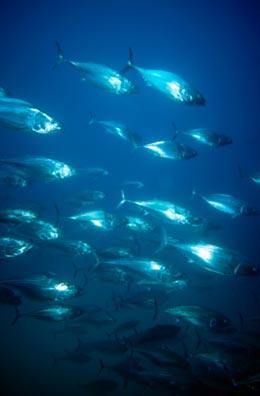 Mercury levels in the Pacific Ocean are rising, a new study suggests.1 The increase may mean that more methylmercury, a human neurotoxin formed when mercury is methylated by microbes, accumulates in marine fish such as tuna. The research comes as researchers and policymakers, who have tended to focus on atmospheric concentrations of the element, are looking for a fuller picture of the mercury cycle. US guidelines on methylmercury in fish are currently under review. It remains unclear exactly how atmospheric mercury — whether dumped directly into oceans or carried there through rivers or coastal deposits — is methylated and eventually taken up by fish, which are a major source of human exposure to methylmercury. But the new data, collected by Elsie Sunderland of Harvard University and colleagues, also provide a possible mechanism for mercury methylation within the ocean. The researchers collected samples from the eastern North Pacific, an area also monitored by research cruises in 1987 and 2002.2 They estimate that methylated mercury accounts for as much as 29% of all mercury in subsurface ocean waters, with lower concentrations occurring in deeper water masses. The group’s modelling indicates that atmospheric deposition of mercury could lead to a doubling of the total ocean mercury concentrations recorded in the mid-1990s by 2050. …
Mercury levels in the Pacific Ocean are rising, a new study suggests.1 The increase may mean that more methylmercury, a human neurotoxin formed when mercury is methylated by microbes, accumulates in marine fish such as tuna. The research comes as researchers and policymakers, who have tended to focus on atmospheric concentrations of the element, are looking for a fuller picture of the mercury cycle. US guidelines on methylmercury in fish are currently under review. It remains unclear exactly how atmospheric mercury — whether dumped directly into oceans or carried there through rivers or coastal deposits — is methylated and eventually taken up by fish, which are a major source of human exposure to methylmercury. But the new data, collected by Elsie Sunderland of Harvard University and colleagues, also provide a possible mechanism for mercury methylation within the ocean. The researchers collected samples from the eastern North Pacific, an area also monitored by research cruises in 1987 and 2002.2 They estimate that methylated mercury accounts for as much as 29% of all mercury in subsurface ocean waters, with lower concentrations occurring in deeper water masses. The group’s modelling indicates that atmospheric deposition of mercury could lead to a doubling of the total ocean mercury concentrations recorded in the mid-1990s by 2050. …
Ocean mercury on the increase
Mercury levels in the Pacific Ocean are rising, a new study suggests.1 The increase may mean that more methylmercury, a human neurotoxin formed when mercury is methylated by microbes, accumulates in marine fish such as tuna. The research comes as researchers and policymakers, who have tended to focus on atmospheric concentrations of the element, are looking for a fuller picture of the mercury cycle. US guidelines on methylmercury in fish are currently under review. It remains unclear exactly how atmospheric mercury — whether dumped directly into oceans or carried there through rivers or coastal deposits — is methylated and eventually taken up by fish, which are a major source of human exposure to methylmercury. But the new data, collected by Elsie Sunderland of Harvard University and colleagues, also provide a possible mechanism for mercury methylation within the ocean. The researchers collected samples from the eastern North Pacific, an area also monitored by research cruises in 1987 and 2002.2 They estimate that methylated mercury accounts for as much as 29% of all mercury in subsurface ocean waters, with lower concentrations occurring in deeper water masses. The group’s modelling indicates that atmospheric deposition of mercury could lead to a doubling of the total ocean mercury concentrations recorded in the mid-1990s by 2050. …